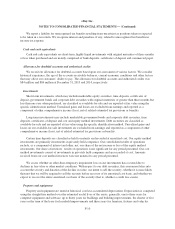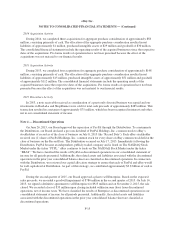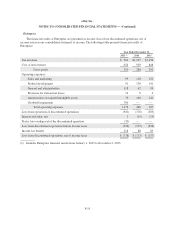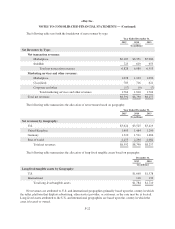eBay 2015 Annual Report Download - page 86
Download and view the complete annual report
Please find page 86 of the 2015 eBay annual report below. You can navigate through the pages in the report by either clicking on the pages listed below, or by using the keyword search tool below to find specific information within the annual report.eBay Inc.
NOTES TO CONSOLIDATED FINANCIAL STATEMENTS — (Continued)
Concentration of credit risk
Our cash, cash equivalents, accounts receivable and derivative instruments are potentially subject to
concentration of credit risk. Cash and cash equivalents are placed with financial institutions that management
believes are of high credit quality. Our accounts receivable are derived from revenue earned from customers. In
each of the years ended December 31, 2015, 2014 and 2013, no customer accounted for more than 10% of net
revenues. Our derivative instruments expose us to credit risk to the extent that our counterparties may be unable
to meet the terms of the agreements.
Recent Accounting Pronouncements
In 2014, the FASB issued new guidance related to reporting discontinued operations. This new standard raises
the threshold for a disposal to qualify as a discontinued operation and requires new disclosures of both discontinued
operations and certain other disposals that do not meet the definition of a discontinued operation. The new standard
is now effective. The standard impacted the presentation of Enterprise during the second quarter of 2015 and PayPal
during the third quarter of 2015 related to the financial statement presentation of assets held for sale and
discontinued operations and required additional disclosures as presented in “Note 4 — Discontinued Operations.”
In 2014, the FASB issued new accounting guidance related to revenue recognition. This new standard will
replace all current GAAP guidance on this topic and eliminate all industry-specific guidance. The new revenue
recognition guidance provides a unified model to determine when and how revenue is recognized. The core
principle is that a company should recognize revenue to depict the transfer of promised goods or services to
customers in an amount that reflects the consideration for which the entity expects to be entitled in exchange for
those goods or services. This guidance can be applied either retrospectively to each period presented or as a
cumulative-effect adjustment as of the date of adoption. In 2015, the FASB issued guidance to defer the effective
date to fiscal years beginning after December 15, 2017 with early adoption for fiscal years beginning
December 15, 2016. We are evaluating the impact of adopting this new accounting guidance on our consolidated
financial statements.
In 2015, the FASB issued new guidance related to consolidations. The new standard amends the guidelines
for determining whether certain legal entities should be consolidated and reduces the number of consolidation
models. The new standard is effective for fiscal years, and interim periods within those fiscal years, beginning
after December 15, 2015. Early adoption is permitted. We are evaluating the impact, if any, of adopting this new
accounting guidance on our consolidated financial statements.
In 2015, the FASB issued new guidance related to presentation of debt issuance costs. The new standard
requires that debt issuance costs related to a recognized debt liability be presented in the balance sheet as a direct
deduction from the carrying amount of that debt liability. The new standard is effective for fiscal years, and
interim periods within those fiscal years, beginning after December 15, 2015. Early adoption is permitted. The
adoption of this standard is not expected to have a material impact on our consolidated financial statements.
In 2015, the FASB issued new guidance related to accounting for fees paid in a cloud computing
arrangement. The new standard provides guidance to customers about whether a cloud computing arrangement
includes a software license. If a cloud computing arrangement includes a software license, then the customer
should account for the software license element of the arrangement consistent with the acquisition of other
software licenses. If a cloud computing arrangement does not include a software license, the customer should
account for the arrangement as a service contract. The new standard is effective for fiscal years, and interim
periods within those fiscal years, beginning after December 15, 2015. Early adoption is permitted. We are
evaluating the impact, if any, of adopting this new accounting guidance on our consolidated financial statements.
F-12
























